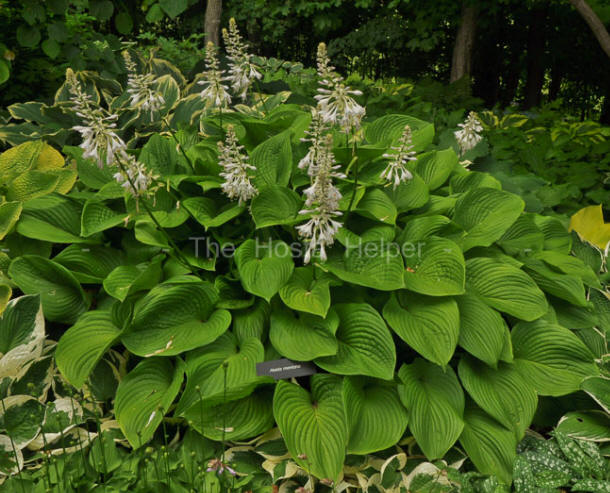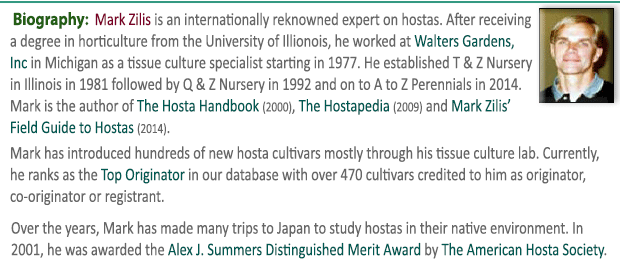|
 H. montana is a species that is found throughout its
native
Japan where it is called
Hosta 'Oga Gibōshi'.
Liberty Hyde Bailey originally named the plant
H.
fortunei var gigantea. H. montana is a species that is found throughout its
native
Japan where it is called
Hosta 'Oga Gibōshi'.
Liberty Hyde Bailey originally named the plant
H.
fortunei var gigantea.
 This species forms a large size (28 inches high
by 78 inches wide), vase-shaped mound
of medium green foliage that is deeply veined, moderately wavy
with a moderately lobed leaf base. This species forms a large size (28 inches high
by 78 inches wide), vase-shaped mound
of medium green foliage that is deeply veined, moderately wavy
with a moderately lobed leaf base.
One of the unique characteristics is that the
flower bud itself looks like a flower. It has open funnel shaped, very pale lavender flowers
in July with bracts on the
flower scape after the flower opens.
Plants of this species also tend to emerge early in the spring
and are often susceptible to damage from frosts if not
protected.
There seems to be a lot of variation within this species and
The Hostapedia by
Mark Zilis (2009) divided the species into six groups:
1. H. montana - the "typical" green-leaved species;
2.
H. montana 'Aureomarginata'- Yellow margined
3.
H. montana 'Mountain
Snow'- White margined
4. H. montana 'Choko Nishiki'- Gold centered
5. H. montana 'Emma Foster'- Gold leaf
6. H. montana macrophylla
According to
The Hostapedia by Mark Zilis (2009), "Of the four most common species
in
Japan (H. sieboldii,
H. kikutii
and H. longipes being the others),
H. montana is the
most consistent...has proven to be a valuable breeding plant and
is the source of several significant mutations."
 The New Encyclopedia of Hostas by
Diana
Grenfell (2009) states: "Very variable in the wild. Usually much larger in
cultivation. Emerges later than its best-known sport, H. montana 'Aureomarginata'.
The parent of many large-leaved hybrids...Very long, dense racemes and numerous
leafy bracts. Heavy production of pods weighs the scape down." The New Encyclopedia of Hostas by
Diana
Grenfell (2009) states: "Very variable in the wild. Usually much larger in
cultivation. Emerges later than its best-known sport, H. montana 'Aureomarginata'.
The parent of many large-leaved hybrids...Very long, dense racemes and numerous
leafy bracts. Heavy production of pods weighs the scape down."
Mark Zilis' Field Guide to Hostas (2014)
states that this species was found in Japan in "...open
grasslands near Mt. Fuji; woodlands; rocks & cliffs; along
streams..."

 An article by
Hajime
Sugata of Japan in
The
Hosta Journal (1994 Vol. 25 No. 2) states that "One of
the unique characteristics of H. montana is that it
sometimes grows close to developed areas. It can be found
densely populated, sparsely distributed, and occasionally as a
single plant. Dense growth of H. montana is found along
the edges of rice paddies. Although some are cut or pulled out
with weeds by farmers during the rice planting time in May,
H. montana is not discouraged. An article by
Hajime
Sugata of Japan in
The
Hosta Journal (1994 Vol. 25 No. 2) states that "One of
the unique characteristics of H. montana is that it
sometimes grows close to developed areas. It can be found
densely populated, sparsely distributed, and occasionally as a
single plant. Dense growth of H. montana is found along
the edges of rice paddies. Although some are cut or pulled out
with weeds by farmers during the rice planting time in May,
H. montana is not discouraged.
There are many regionally modified forms. A white-backed form
exists around Kansenji Temple in Tsukude Village, Minamishitara
County, a large clump form at Mitashi, Atsuke Town, and a small
and thick-leaf form, tolerant of direct sunlight and drought,
along the banks of the Hida River, Gifu Pref."






 |



